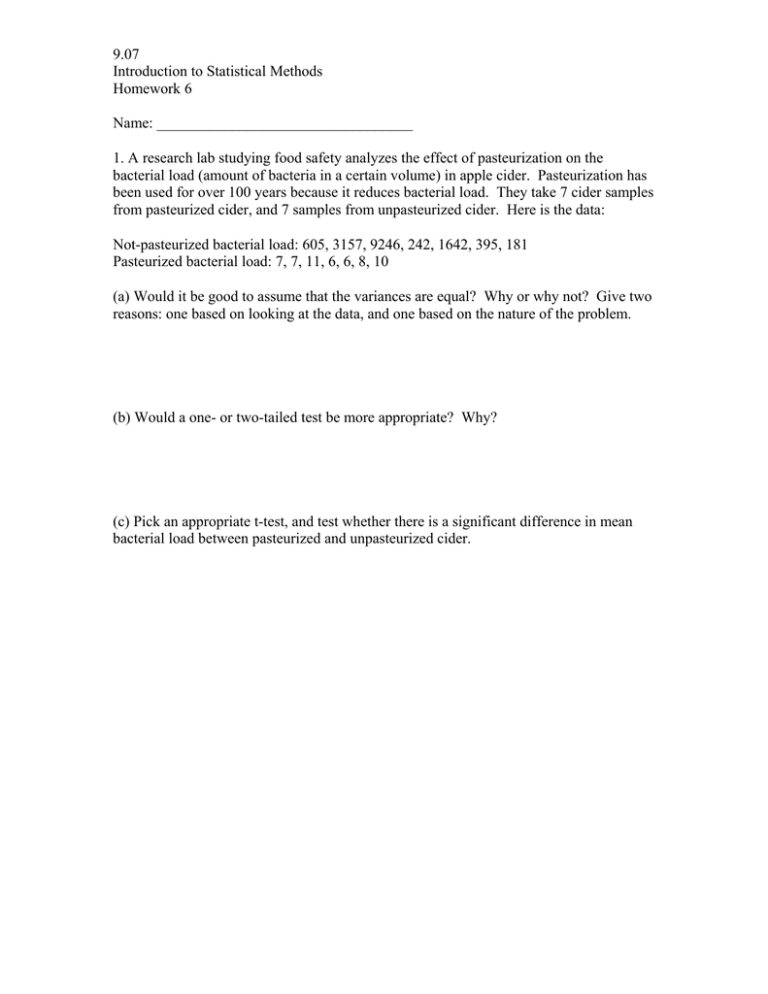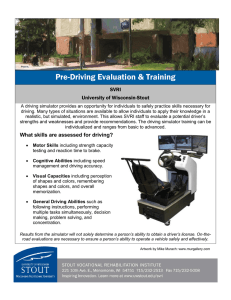9.07 Introduction to Statistical Methods Homework 6 Name: __________________________________
advertisement

9.07 Introduction to Statistical Methods Homework 6 Name: __________________________________ 1. A research lab studying food safety analyzes the effect of pasteurization on the bacterial load (amount of bacteria in a certain volume) in apple cider. Pasteurization has been used for over 100 years because it reduces bacterial load. They take 7 cider samples from pasteurized cider, and 7 samples from unpasteurized cider. Here is the data: Not-pasteurized bacterial load: 605, 3157, 9246, 242, 1642, 395, 181 Pasteurized bacterial load: 7, 7, 11, 6, 6, 8, 10 (a) Would it be good to assume that the variances are equal? Why or why not? Give two reasons: one based on looking at the data, and one based on the nature of the problem. (b) Would a one- or two-tailed test be more appropriate? Why? (c) Pick an appropriate t-test, and test whether there is a significant difference in mean bacterial load between pasteurized and unpasteurized cider. 9.07 Introduction to Statistical Methods Homework 6 Name: __________________________________ 2. Suppose a microscopist has just identified two potentially different types of cells based upon differential staining. She separates them out into two groups, amber cells (AC), and blue cells (BC). She suspects there may be a difference in cell wall thickness between the two types of cells. Measuring the cell wall thicknesses for a number of cells, she gets the following data: Parameter Mean SD N AC-type 8.57 2.39 14 BC-type 8.40 2.74 18 With the SD’s so close together, assume that an equal-variance assumption is valid. Is there a significant difference between the two cell types, in terms of cell wall thickness? 3. An examination was given to a random sample of 50 students from a public high school, and a sample of 65 students from a Catholic high school. In the public school sample, the mean grade was 70, while in the Catholic high school it was 74. Test scores are known to be normally distributed in both schools. The standard deviations in scores were 4 at the public school, and 6 at the Catholic school. (a) What statistical test is appropriate for testing whether there is a significant difference between the mean scores at the two schools, and why? (b) Test whether the difference is significant, with a=0.05. 9.07 Introduction to Statistical Methods Homework 6 Name: __________________________________ 4. 9 students in each of two statistics classes (A and B) were carefully matched according to age, sex, grade point average, and SAT scores. The two groups were then taught statistics by two different methods (but by the same instructor). Their scores on the (same) final exam were as follows: Pair 1 2 3 4 5 6 7 8 9 A Score 76 85 83 84 65 71 60 76 72 B Score 83 91 72 93 75 87 75 79 74 Is there a significant difference (at the 0.05 level) between using teaching method A and teaching method B? 9.07 Introduction to Statistical Methods Homework 6 Name: __________________________________ 5. A sample poll of 30 voters from district A, and 30 voters from district B, showed that 56% and 48%, respectively, were in favor of a given bond measure. (a) Using α=0.05, test whether the two districts differ in their support for this bond measure. (b) What kind of test should you use, and why? (c) Construct the approximate 95% confidence interval for p1 – p2. According to the confidence interval, should the null hypothesis be accepted or rejected? 6. For problem #4, show what happens if we erroneously assume that the two sets of scores are independent. You may assume that the variances are known to be equal. Do we find a significant difference? 9.07 Introduction to Statistical Methods Homework 6 Name: __________________________________ 7. A researcher wants to test the hypothesis that video game players are better at spatial judgments than non-video game players. He gives a spatial aptitude test to 15 students who play video games at least 10 hours a week, and to 20 students who play less than 1 hour a week. The mean spatial aptitude score for the video game players is 120. The mean spatial aptitude score for the non-players is 100. The standard deviations are 20 and 50. (a) Is this an observational study or a controlled experiment? (b) Is the difference in mean aptitude score for the two groups significantly different at the 0.05 level? At the 0.01 level? (Hint: you should not assume that the two groups have equal variance.) (c) If this study were to find a significant difference, would it show that video game playing improves spatial aptitude? What might be an alternative explanation? 9.07 Introduction to Statistical Methods Homework 6 Name: __________________________________ 8. Fifteen experimental subjects are tested on their driving ability in two driving simulators. Each test involves “driving” through a mock city for approximately an hour, and the simulator rates them according to their driving ability, based upon a complicated function of reaction time, how many simulated people and cats the subjects “hit” during the simulation, and so on. (a) If all subjects try simulator A first, then B (instead of counterbalancing so half the subjects try A first, while the others try B first), and their driving is better in simulator A, what is a possible explanation for the results which has nothing to do with simulator A being somehow better than simulator B? (b) Again, if there’s no counterbalancing, and driving is better in simulator B than in A, what is a possible explanation for the results which has nothing to do with simulator B being better than simulator B? (c) We counterbalance which subjects drive with simulator A first vs. B first. The following is the resulting data. Does there seem to be a significant difference between the two simulators? Subject 1 2 3 4 5 6 7 8 9 10 11 12 13 14 15 Simulator A 8.0 8.4 9.1 10.9 11.8 12.0 12.3 14.8 15.0 16.8 17.2 17.2 17.4 17.5 18.5 Simulator B 9.0 9.0 9.9 10.6 13.6 14.2 14.5 15.2 16.1 16.3 16.8 17.3 17.5 17.6 18.3 9.07 Introduction to Statistical Methods Homework 6 Name: __________________________________ 9 & 10. This homework assignment is a little different. You will get two points just for trying the following problems in the book. For each problem, write down your thoughts about what the answer is (so we can tell you put some thought into the problems). Then look up the answer in the back of the book. Some of these problems are pretty tricky. Read Chapters 1 and 2 from your book before attempting these problems! Problems: p. 20-23, # 4, 5, 6, 9, and 12.



